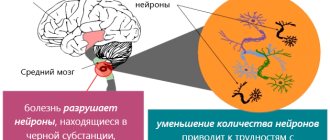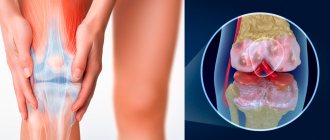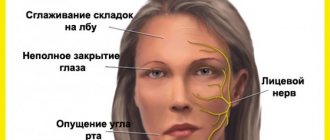More information about other types of diseases starting with the letter “N”: Sleep disturbance; Narcolepsy; Hereditary cerebellar ataxia of Pierre-Marie; Spinal circulatory disorders; Trigeminal neuralgia; Neuralgia of the submandibular and sublingual nodes; Neuralgia of the glossopharyngeal node; Neuralgia of the ear ganglion; Neurasthenia; Neural amyotrophy of Charcot-Marie-Tooth; Acoustic neuroma; Neuroma; Optic neuritis; Pharyngeal neuritis; Neuritis of the facial nerve; Neuritis; Obsessive-compulsive neurosis; Pharyngeal neurosis; Neuroses; Neurosis-like stuttering; Femoral nerve neuropathy.
General concept
Neural amyotrophy of Charcot-Marie-Tooth is a chronic disease of the body that has a hereditary type of formation. A characteristic indicator is damage to the peripheral nervous system. Abnormal processes are manifested in the formation and changes in structure in muscle areas, for example: a decrease in the size of areas at the beginning of the lower extremities, and then the upper ones. In combination with this type of anomaly, the patient may experience hypoesthesia and a decrease in the reflex ability of the tendons, twitching of different parts of the muscles.
Doctors resort to various options for examining a patient with this disease, these include: electromyography, electroneurography, genetic testing, DNA testing, biopsy of nerves and muscle areas. There are no radical treatment methods, but there are methods aimed at ridding a person of symptoms. Doctors prescribe a variety of vitamin complexes, anticholinesterase methods, metabolic techniques, microcirculatory analogues, exercise therapy, physiotherapy, etc.
Treatment of Charcot-Marie-Tooth disease
To date, no cure for Charcot-Marie-Tooth disease has been developed. Symptomatic therapy is used to improve muscle trophism. For this purpose, vitamins, ATP, glucose, cocarboxylase are prescribed, and physiotherapeutic treatment, exercise therapy, and massages can also be used. In some cases, orthopedic and spa treatment is necessary.
In medical genetics, a search is carried out for most of the mutations leading to the development of Charcot-Marie-Tooth disease. We use DNA sequence sequencing as a research method.
Useful information
Neural amyotrophy Charcot-Marie-Tooth (CMT) is included in the list of chronic diseases (polyneuropathies) of a genetic nature that manifest themselves in increased progression. These include:
- Roussy-Lévy syndrome.
- Hypertrophic neuropathy Dejerine-Sotta.
- Refsum's disease and other rarer pathological processes.
According to the average statistical data, scientists state that almost 83% of cases are caused as a result of a person’s hereditary predisposition. Adverse effects in the body occur mostly in men; women are less susceptible to the described disease. Referring to numerous data, neural amyotrophy CMT is diagnosed with a frequency of two to thirty-six cases per hundred thousand of the planet's population. Usually, it is of a family nature. However, among members of the same family, clinical symptoms may be expressed differently. At the same time, doctors also observe sporadic variants of CMT. Medical staff note a clear relationship with Friedreich loss of coordination. Some patients in different situations experience typical symptoms of one or another disease. Sometimes, over many years, the symptoms of one anomaly may be replaced by the symptoms of another.
Short description
Charcot–Marie–Tooth disease combines hereditary sensorimotor neuropathies types I and II. The disease is characterized by weakness and atrophy of the distal group of muscles of the lower extremities and is usually autosomal - dominant type of inheritance; often combined with other neurodegenerative diseases (for example, Friedreich's ataxia).
Code according to the international classification of diseases ICD-10:
- G60.0 Hereditary motor and sensory neuropathy
Pathogenesis of neural amyotrophy Charcot-Marie-Tooth
In medicine at the moment there is no accurate and reliable information about the origin and mechanism of neural amyotrophy. According to the experiments, it became clear only that in almost 75% of patients with this diagnosis who underwent genetic consultation, a repetition of a certain zone of the 17th chromosome was identified. It is already known that the disease has several groups, caused by various gene mutations. For example, during a study of a patient with CMT, which manifests itself due to a mutation in the MFN2 gene protein, mitochondria particles begin to appear. As a result, a person experiences a disruption in the movement of these elements along the axon.
A large number of forms appear due to damage to the myelin outer layer of fibers. Much less often you can notice forms with deviations from the norm of axons - objects of axial direction that pass in the central part of the nervous structure. Abnormal processes can affect the condition of the anterior and posterior processes of the spinal cord, neurons of the anterior horns, Gaulle's pathways and Clark's columns. Again, due to problems with the functioning of the peripheral region, muscle insufficiency begins to form.
Varieties and classification
In the neurological direction of medicine, neural amyotrophy of Charcot-Marie-Tooth is divided into two clear groups, which are clinically quite similar to each other, but have a list of features that allow such a distinction to be made:
- Neural amyotrophy type I - causes a decrease in the speed of nerve impulses.
- ON type II - speed is adversely affected to a lesser extent, neurite deviation is manifested.
Tests and diagnostics
Patients with suspected Charcot-Marie-Tooth disease are examined by neurologists and orthopedists. During the initial examination, the patient’s age at which characteristic symptoms first began to appear is determined. It is mandatory to collect a family history, specifying whether relatives have similar genetic diseases. During the examination, the doctor pays attention to deformation of the hands and feet, and changes in gait.
During a neurological examination, a decrease in tone in the distal parts of the upper and lower extremities, a decrease in the sensitivity of the skin and a weakening (up to complete absence) of tendon reflexes (knee, Achilles) are revealed.
Basic research methods:
- ENMG . Signs of demyelinating and axonal neuropathy are diagnosed, which is manifested by a drop in the amplitude of M-responses and a decrease in the speed of impulses along the motor nerves.
- Histology . myelin atrophy , a decrease in the number of myelin fibers, and proliferation of connective tissue fibers are noted. When performing a biopsy of the nerve fiber, a characteristic morphological sign is revealed - “bulb heads”.
- Computer pallesthesiometry . The diagnostic procedure allows us to identify the presence or absence of a decrease in vibration sensitivity, which is the earliest sign of the disease.
- DNA analysis . To fully verify the diagnosis, a DNA analysis is performed, which reveals a duplication of the PMP22 gene, a peripheral myelin protein, on chromosome 17.
Differential diagnosis is carried out with diseases:
- Guillain-Barre syndrome;
- adrenoleukodystrophy;
- Werdnig-Hoffmann spinal muscular ;
- Pelizaeus-Merzbacher disease.
What are the manifestations of Charcot-Marie-Tooth neural amyotrophy?
With the described disease in humans, the first thing that begins is the formation of similar muscle necrosis in the lower extremities. The first manifestations, as a rule, occur at the age of twenty (much less often, doctors can diagnose symptoms in adolescence from 16 years, and also up to 30 years). Such manifestations consist mainly of a high degree of fatigue of the legs during a long stay in an upright position. The so-called “trampling” syndrome has been noticed, that is, in order for the patient to relieve discomfort, he begins to walk in place. In some rare situations, AN manifests itself as a disorder of the sensitivity of the same parts, most often - paresthesia is formed in the form of crawling goosebumps.
A typical early sign of cervical mastication is the complete absence of Achilles and patellar tendon reflexes. As a result, the patient develops a drooping arch, an inability to walk on his heels, and an abnormal gait that is similar to that of a horse. Subsequently, the harmful process increases the degree of progression further and affects the muscles and flexors. The maximum level of necrosis can lead to complete deformation of the legs with a high arch, similar to the Friedreich foot type. Gradually, CMT moves to the proximal areas, which include the legs and lower thighs. The patient begins to develop serious deformities: drooping feet, legs becoming abnormally shaped. Next, the hands are affected, the hand becomes like a monkey's paw.
It is worth knowing that harmful lesions never affect the muscles of the cervical perimeter, torso and shoulder area. In addition to the above symptoms, the patient may experience the following problems:
- Faint twitching.
- Hypertrophy of the compensatory nature of muscle areas.
- Sensory impairments.
- Possibility of cyanosis and swelling of the skin.
CMT typically develops symptoms slowly. The period of development of the process of reduction in the size of the legs and arms can take up to ten years. Even with such serious deformations of the body, the patient is able to maintain working capacity for a long time and normally perform various household duties. The following factors may precipitate symptoms:
- Entry of infectious agents into the body.
- Long stay in the cold.
- Head injuries.
- Damage to the back and spinal cord.
- Lack of vitamins in the body.
Spinal amyotrophies
Spinal amyotrophy is a progressive disease that affects the nerve cells of the spinal cord. This is not just one disease, it includes a whole group of diseases: Arand-Duchenne disease, Werding-Hoffman disease and a number of other rarer diseases.
Despite the large number of diseases included in this group, they all manifest similar symptoms. This is expressed in the fact that flaccid paralysis develops over time and the tendons weaken. As a rule, the lesions are asymmetrical. The peculiarity of each disease is that different muscle groups are affected first.
For example, with Werding-Hoffman disease, the patient experiences weakness, mainly affecting the muscles of the torso. Researchers note a high percentage of consanguinity among the parents of the sick. This disease is divided into types depending on the time of onset and progression of the disease: congenital, early childhood and late.
From the editor: Methods for developing the right hemisphere of the brain
The development of congenital amyotrophy occurs in the first months of a baby’s life. This disease is usually combined with other defects. If treatment is delayed, there is a high risk of death. The cause of the latter is cardiovascular and respiratory failure, which develops due to weakness of the respiratory muscles.
Early childhood amyotrophy develops between the ages of six months and one year. Initially, the muscles of the torso and legs are affected, and subsequently the functioning of all muscle groups is disrupted. This disease is quite easy to detect.
The baby cannot stand on his legs, cannot sit, and has difficulty grasping toys. A characteristic feature is also a slight twitching of the muscles, especially the tongue. If treatment is not started in time, complete muscle hypotonia and paralysis develop. A child with this disease does not live to see 15 years of age.
Late amyotrophy manifests itself between the ages of two and a half and three and a half years. At this time, the child is already firmly on his feet and moves freely in space.
Symptoms of this disease include unsteadiness when walking and frequent falls. This disease gradually progresses, affecting an increasingly larger group of muscles. As a result, by the age of ten, the child stops moving independently and cannot take care of himself. A person can live with such a disease only for a maximum of 30 years.
Benign spinal amyotrophy of Kugelberg-Welander. A separate disease that is included in the group of diseases of spinal amyotrophy. A separate group of researchers believes that this disease is a type of Werding-Hoffman disease.
This disease progresses slowly, usually developing in the muscles of the trunk and gradually spreading to the limbs. Accompanied by general weakness. It is observed in children aged three to seventeen years. A characteristic feature of this disease is also excess body weight. People with such diseases live to a ripe old age and retain the ability to move independently.
Arand-Ducher's disease is observed in elderly people. Characterized by weakening of the muscles of the limbs. The course of the disease itself is slow. Muscle twitching and, in some cases, paralysis are observed. Death in this disease occurs from bronchopneumonia.
Diagnostic options
To diagnose Charcot-Marie-Tooth AN, medical workers rely on such manifestations as:
- The age at which the first signs of the disease appeared.
- Standard clinical picture.
- Similar nature of destruction of the body.
- Slow degree of development of atrophies.
- Increased risk of symptoms.
During a visit to a specialist’s office, a person will undergo a full examination of the body to identify the presence of muscle weakness in the feet and legs, changes, absence or serious decrease in the level of reflex abilities of the Achilles and knee region, hypoesthesia. In order to distinguish CMT from other neuromuscular disorders, doctors create a series of examinations that the infected person will need to undergo. These include:
- Electromyographic study.
- Electroneurography.
- Analysis of blood cells for sugar, hormonal levels and narcotic substances.
- Consultation with a specialist in the field of genetics.
- DNA assessment or genome sequencing (the latter option is very expensive for widespread use).
- Biopsy.
Risk factors and causes of CMT
CMT is a hereditary disease, so people who have close relatives with the disease have a higher risk of developing the disease.
The disease affects peripheral nerves. Peripheral nerves are made up of two main parts: the axon, which is the inner part of the nerve, and the myelin sheath, which is the protective layer around the axon. CMT can affect the axon and myelin sheath.
At CMT 1
genes that cause the breakdown of the myelin sheath are mutated. Eventually, the axon is damaged and the patient's muscles no longer receive clear messages from the brain. This leads to muscle weakness and loss of sensation or numbness.
For CMT 2
the mutating gene directly affects axons. The signals are not transmitted strongly enough to activate the muscles and senses, so patients have weak muscles, poor sensation, or numbness.
ShMT 3
or Dejerine-Sottas disease
, a rare type of disease. Damage to the myelin sheath leads to severe muscle weakness and soreness. Symptoms may be noticeable in children.
ShMT 4
is a rare disease that affects the myelin sheath. Symptoms usually begin in childhood and patients often require a wheelchair.
ShMT X
caused by a mutation on the X chromosome. It is more common in men. A woman with CMT X will have very mild symptoms.
Diagnostics
The diagnostic procedure includes a number of methods, including:
- detailed personal and family history;
- clinical assessment of muscle strength, sensitivity;
- electrophysiological study of nerve fiber conduction velocity;
- neurological examination.
The most common forms of the disease can be diagnosed by testing DNA from the patient's blood.
Diagnosis requires close collaboration between a neurologist, geneticist, rehabilitation specialist, orthopedic surgeon and prosthetist. In accordance with the findings of the examination, recommendations are given regarding an individual rehabilitation plan, and if necessary, orthopedic surgery is prescribed.
Significant variability in the clinical signs of the disease, along with the lack of knowledge about it among many doctors, often leads to incorrect diagnosis.







